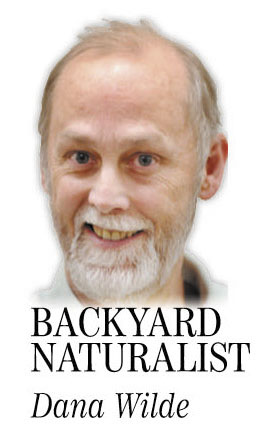Our little clearing on the side of a hill in Troy is surrounded by firs, spruces, pines and some oaks and maples 40 to 50 feet tall, a few probably higher.
As we look south from the front door at this time of year, the midday sun barely clears their tops. So solar heating, when we looked into it, quickly got ruled out.
In June and July, of course, the sun climbs up practically straight overhead and heats the attic to infernal temperatures at exactly the time of year when you don’t need it. Is this another cruel joke by Mother Nature, like the one she plays every May, when just as the year’s first warm, sunny day arrives you can’t go outside because squadrons of black flies will eat you?
Well, I’m not saying there’s no joke there; but there is a mechanism behind longer, warmer days and shorter, colder days.
The Earth spins, wheeling us in and out of the sun’s rays every 24 hours. However, the spin is not straight up and down in relation to the sun. It’s tilted by a little more than 23 degrees. So the North Pole and South Pole alternately face toward and away from the sun as the Earth makes its 365.2-day orbit.
To get what’s happening clear in your mind, imagine a tennis ball spinning in front of your face. The ball is the Earth, and your head is the sun. The top of the ball has an N (for North Pole), and the bottom has an S (for South Pole). If the ball spins straight up and down in relation to your face, you can just see both the N and the S. But if the top of the ball tilts toward you a little bit, you see the N but the S is out of sight. So the light from your sun-face is shining on the N. But the S is tilted away and gets no light. (You could hold a flashlight on this tilted ball and see where the actual shadow starts.)
Now holding the ball steady, with its 23-degree tilt, circle it around your head until it’s behind you. If you turn and face it, now the S at the bottom is tilted toward you. The N at the top is tilted away. The light from your sun-face now shines on the ball’s South Pole, and the North Pole is in the dark.
This is what’s happening to the Earth as it revolves around the sun. When the North Pole is tilted toward the sun, more light rays strike us. The Northern Hemisphere is spinning through the sun’s rays longer (the sun rises earlier and sets later), while the Southern Hemisphere spins through the rays for a shorter time.
It’s summer in the north, winter in the south.
When the North Pole is tilted toward the sun, the rays also strike the Northern Hemisphere at more direct angles. So during the summer, we not only get more light in the form of earlier sunrises and later sunsets, but also more heat energy from more direct rays. In winter, when we’re tilted away from the sun, we get shorter days and less heat from the less direct rays.
Since it takes about 365 days for the Earth to travel once around the sun, the change from long days to short days and back again is gradual. That is, our orbit takes the tilt gradually around. On the day the North Pole is leaning most directly toward the sun, we have our longest day of the year. This is the summer solstice, occurring each year around June 21.
At Maine’s latitudes (just about halfway between the equator and the pole — Troy is at latitude 44 degrees, 6 minutes; Bingham is just about exactly 45 degrees) the longest day is 15 hours and 38 minutes, the sun’s topmost reach in the sky is at an angle of about 69 degrees, and direct rays bear in high over the firs and bake my attic well into the afternoon.
As the Earth continues its orbit, the tilt from day to day points farther away from the sun. Days get shorter. The highest rays each day are slowly closer to the fir tops; and six months later, at the winter solstice, around Dec. 21, the shortest day of the year is eight hours 46 minutes and the highest point the sun reaches is about 22 degrees, barely peeking over my trees.
This still does not explain nature’s warped sense of humor. As the eminent astronomer Arthur Eddington pointed out last century, science has no means of explaining why a joke is funny. It explains mechanisms really well, but not the sheepishness you feel when you get irritated by the fact that solar heat is so abundant exactly when you don’t need it.
“O Lord forgive my little jokes on thee,” prayed Robert Frost, “and I’ll forgive thy great big one on me.”
The circuits of the sun and seasons are one of the most amazing.
Dana Wilde lives in Troy. His writings on Maine’s natural world are collected in “The Other End of the Driveway,” available from Booklocker.com. Backyard Naturalist appears the second and fourth Thursdays of the month. You can contact him at naturalist@dwildepress.net.
Send questions/comments to the editors.



Success. Please wait for the page to reload. If the page does not reload within 5 seconds, please refresh the page.
Enter your email and password to access comments.
Hi, to comment on stories you must . This profile is in addition to your subscription and website login.
Already have a commenting profile? .
Invalid username/password.
Please check your email to confirm and complete your registration.
Only subscribers are eligible to post comments. Please subscribe or login first for digital access. Here’s why.
Use the form below to reset your password. When you've submitted your account email, we will send an email with a reset code.